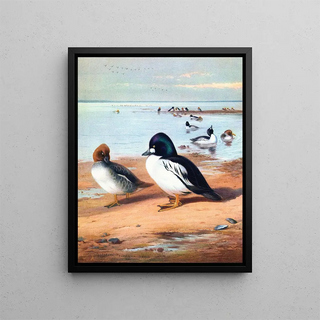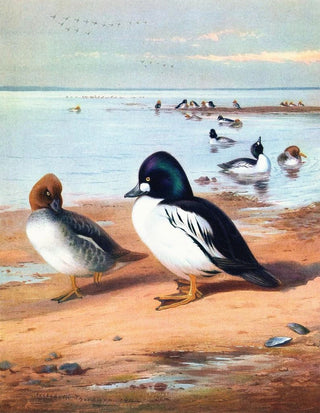Art print | Œil d'or - Archibald Thorburn


View from behind

Frame (optional)
Œil d'or - Archibald Thorburn – Captivating Introduction
In the vast panorama of art history, certain works stand out for their ability to capture the very essence of nature. "Œil d'or - Archibald Thorburn" is one of those creations that emerge with a striking visual and emotional impact. This piece, evoking wild beauty and the majesty of natural landscapes, transports us to a world where harmony between man and nature is celebrated. Through an attentive gaze, the viewer is invited to explore the subtleties of fauna and flora, while immersing themselves in an atmosphere filled with serenity and contemplation. Thorburn, with his undeniable talent, manages to establish an intimate dialogue between the observer and the depicted subject, making this work unforgettable.
Style and uniqueness of the work
The originality of "Œil d'or" lies in how Thorburn succeeds in blending realism and poetry. Every detail, from the delicate feather of a bird to the texture of foliage, is rendered with a precision that borders on hyperrealism. However, beyond this technical meticulousness, it is the emotion that shines through the composition that gives the work its strength. The vibrant colors and play of light create an almost magical atmosphere, where nature seems to come alive. The choice of viewpoints and the staging of natural elements demonstrate a true artistic sensibility, transforming this painting into a living tableau. The viewer's eye is guided along a visual path where each element tells a story, enriching the experience of contemplation.
The artist and his influence
Archibald Thorburn is an iconic figure in British animal and landscape art, whose work profoundly marked his era. Born at the end of the 19th century, he captured the spirit of his time while anticipating future artistic movements. His passion for nature and his commitment to wildlife preservation are reflected in each of his creations. Thorburn did not merely paint; he was also a knowledgeable naturalist, meticulously studying the subjects he depicted. This scientific approach, combined with his artistic talent, allowed him to

Matte finish

View from behind

Frame (optional)
Œil d'or - Archibald Thorburn – Captivating Introduction
In the vast panorama of art history, certain works stand out for their ability to capture the very essence of nature. "Œil d'or - Archibald Thorburn" is one of those creations that emerge with a striking visual and emotional impact. This piece, evoking wild beauty and the majesty of natural landscapes, transports us to a world where harmony between man and nature is celebrated. Through an attentive gaze, the viewer is invited to explore the subtleties of fauna and flora, while immersing themselves in an atmosphere filled with serenity and contemplation. Thorburn, with his undeniable talent, manages to establish an intimate dialogue between the observer and the depicted subject, making this work unforgettable.
Style and uniqueness of the work
The originality of "Œil d'or" lies in how Thorburn succeeds in blending realism and poetry. Every detail, from the delicate feather of a bird to the texture of foliage, is rendered with a precision that borders on hyperrealism. However, beyond this technical meticulousness, it is the emotion that shines through the composition that gives the work its strength. The vibrant colors and play of light create an almost magical atmosphere, where nature seems to come alive. The choice of viewpoints and the staging of natural elements demonstrate a true artistic sensibility, transforming this painting into a living tableau. The viewer's eye is guided along a visual path where each element tells a story, enriching the experience of contemplation.
The artist and his influence
Archibald Thorburn is an iconic figure in British animal and landscape art, whose work profoundly marked his era. Born at the end of the 19th century, he captured the spirit of his time while anticipating future artistic movements. His passion for nature and his commitment to wildlife preservation are reflected in each of his creations. Thorburn did not merely paint; he was also a knowledgeable naturalist, meticulously studying the subjects he depicted. This scientific approach, combined with his artistic talent, allowed him to






